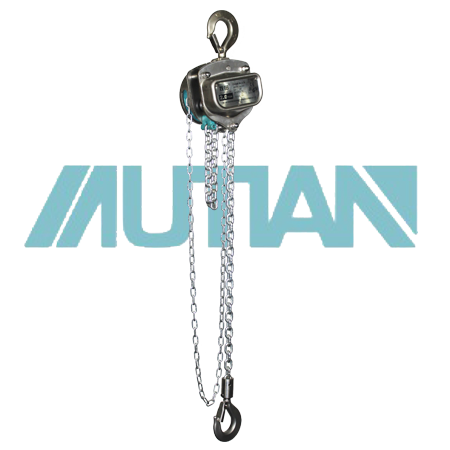 中文版
中文版



Welcome to contact us by phone:0086-0312-7969888
Stainless steel is often used in the construction of corrosion-resistant hand chain hoists due to its excellent resistance to corrosion and durability in harsh environments. Several grades of stainless steel may be employed, depending on the specific requirements of the application. Some common grades used for corrosion-resistant hand chain hoists include:
304 Stainless Steel: Also known as 18-8 stainless steel, grade 304 is one of the most widely used stainless steel grades. It offers good corrosion resistance in many environments, including those with mild chemical exposure and atmospheric conditions. Grade 304 is suitable for general-purpose corrosion-resistant applications.
316 Stainless Steel: Grade 316 stainless steel is known for its superior corrosion resistance, particularly in chloride-rich environments such as marine and offshore applications. It contains higher levels of chromium and nickel compared to 304 stainless steel, making it more resistant to pitting and crevice corrosion. Grade 316 is often used in highly corrosive environments where maximum corrosion resistance is required.
316L Stainless Steel: Grade 316L stainless steel is a low-carbon variant of 316 stainless steel, which offers improved weldability and corrosion resistance. It is commonly used in applications where welding is required, such as fabrication of hoist components, while maintaining excellent corrosion resistance properties.
Duplex Stainless Steel: Duplex stainless steels, such as grades 2205 and 2507, offer a combination of high strength and excellent corrosion resistance. They contain a balanced microstructure of austenite and ferrite phases, providing superior resistance to stress corrosion cracking, pitting, and crevice corrosion. Duplex stainless steels are often used in demanding applications such as offshore oil and gas, chemical processing, and marine environments.
Precipitation-Hardening Stainless Steel: Precipitation-hardening stainless steels, such as grade 17-4 PH, offer high strength and excellent corrosion resistance. They can be heat-treated to achieve a combination of mechanical properties and corrosion resistance, making them suitable for specialized applications where both strength and corrosion resistance are critical.
These are just a few examples of the grades of stainless steel commonly used for corrosion-resistant hand chain hoists. The selection of the appropriate grade depends on factors such as the specific environment, level of corrosion resistance required, mechanical properties, and cost considerations. Manufacturers may also employ other corrosion-resistant materials and coatings in addition to stainless steel to enhance the durability and performance of hand chain hoists in corrosive environments.
X